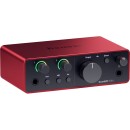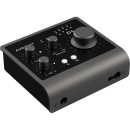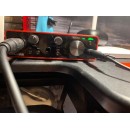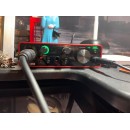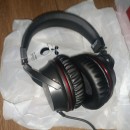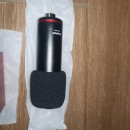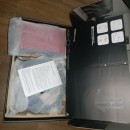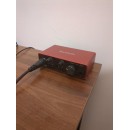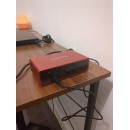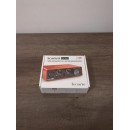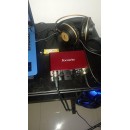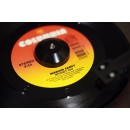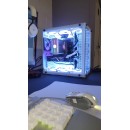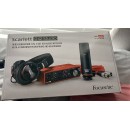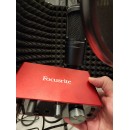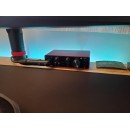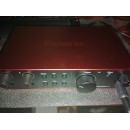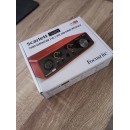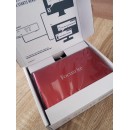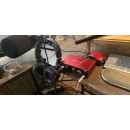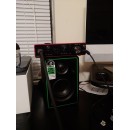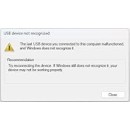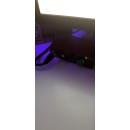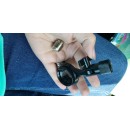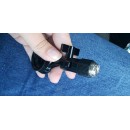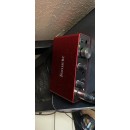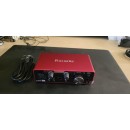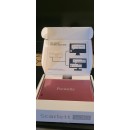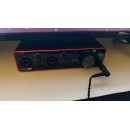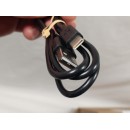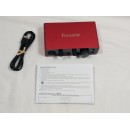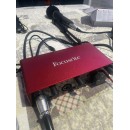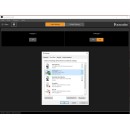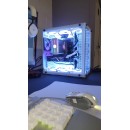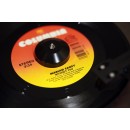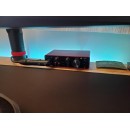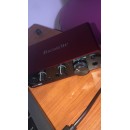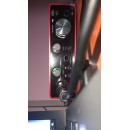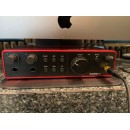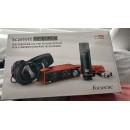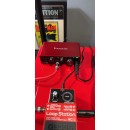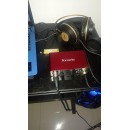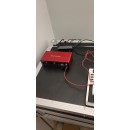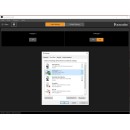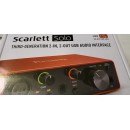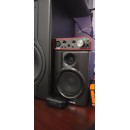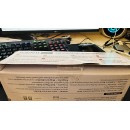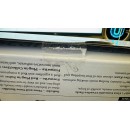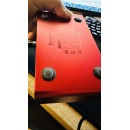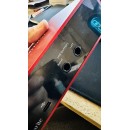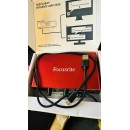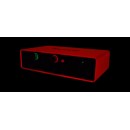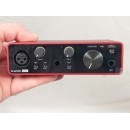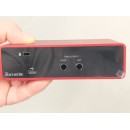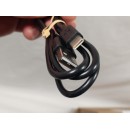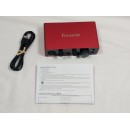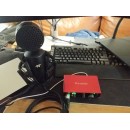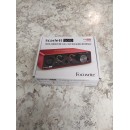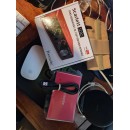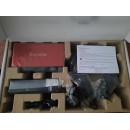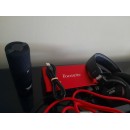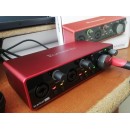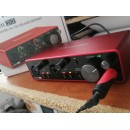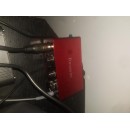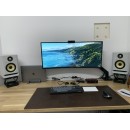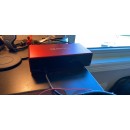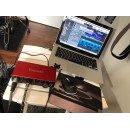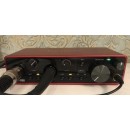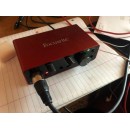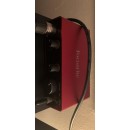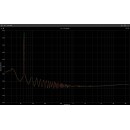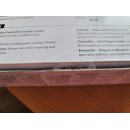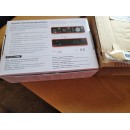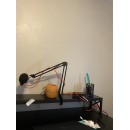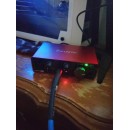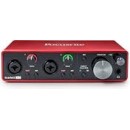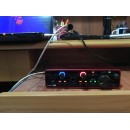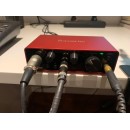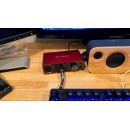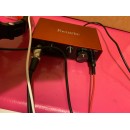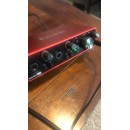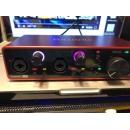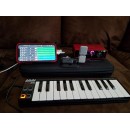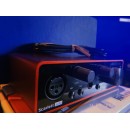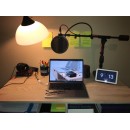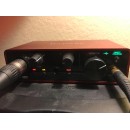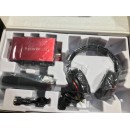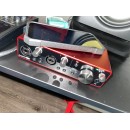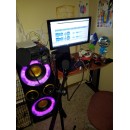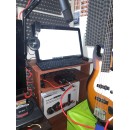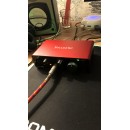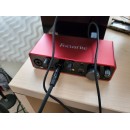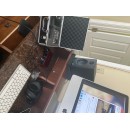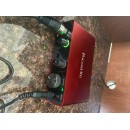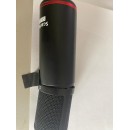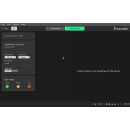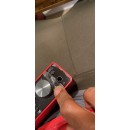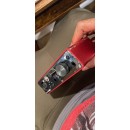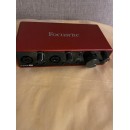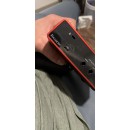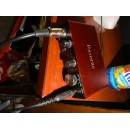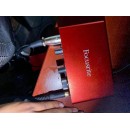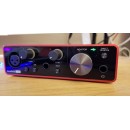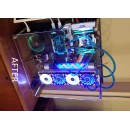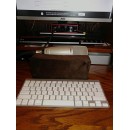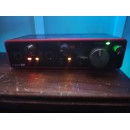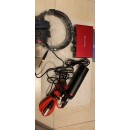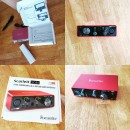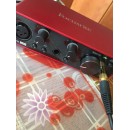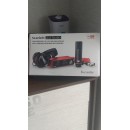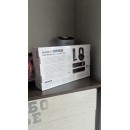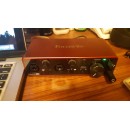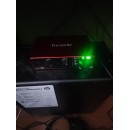Audient iD4 MKII vs Focusrite Scarlett Solo (4th Gen) USB-C Audio Interface: Detailed Comparison
The Focusrite Scarlett Solo (4th Generation) stands out with its sleek design and ease of use, making it an excellent choice for beginners. It features a single XLR input with Focusrite’s renowned preamp, delivering clear, low-noise recordings. Additionally, it has a high-impedance instrument input, ideal for direct guitar or bass recording. The 4th Generation model boasts impressive low-latency performance and high-resolution audio up to 24-bit/192kHz, ensuring professional-quality sound. The interface is powered via USB-C, ensuring a quick and reliable connection to modern computers. Furthermore, the Scarlett Solo includes a comprehensive software bundle with DAWs and plugins, which is a significant advantage for users who are just starting and need a variety of tools to get going.
On the other hand, the Audient iD4 MKII USB-C Audio Interface is tailored for those who demand professional-grade audio quality and robust build. It features Audient’s class-leading console mic preamp, known for its pristine sound and high headroom, along with a JFET instrument input that emulates the input stage of a classic valve amplifier, providing a rich and warm tone for direct instrument recordings. The iD4 MKII supports 24-bit/96kHz audio resolution, slightly lower than the Scarlett Solo but still within professional standards. One of its standout features is the ScrollControl, which turns the big volume knob into a virtual scroll wheel for adjusting DAW parameters and plugin settings seamlessly. The Audient iD4 MKII is also USB-C powered and includes a software bundle, though it is more focused on high-quality plugins rather than DAWs.
In summary, the Focusrite Scarlett Solo (4th Generation) is ideal for beginners and budget-conscious users who require a straightforward, high-quality audio interface with an excellent software bundle. In contrast, the Audient iD4 MKII caters to those who prioritize superior preamp quality and additional features like ScrollControl, making it a strong contender for more experienced users or those seeking top-notch sound fidelity. Both interfaces offer USB-C connectivity and robust software support, ensuring they integrate seamlessly into modern recording setups.
Specifications, Advantages, and Disadvantages
| User Rating Based on Analysis of Reviews | |
|---|---|
|
Show More |
| Pros: | |
|---|---|
|
|
| Cons: | |
|---|---|
|
|
| Find Best Price | Find Best Price |
| Key Specs | |
|---|---|
| Channels of I/O | |
| Analog: 2 Inputs / 2 Outputs at 192 kHz |
Analog: 2 Inputs / 2 Outputs at 96 kHz |
| Maximum Sampling Rate | |
| 192 kHz / 24-Bit | 96 kHz / 24-Bit |
| Number of Microphone Inputs | |
| 1 | 1 Preamp |
| Analog Audio I/O | |
| 1x XLR 3-Pin Balanced Mic Input 1x 1/4" TS Unbalanced Line/Hi-Z Input (Front Panel) 2x 1/4" TRS Balanced Monitor Output 1x 1/4" TRS Headphone Output (Front Panel) |
1x Combo XLR-1/4" TRS Balanced Mic/Line Input 1x 1/4" TRS Unbalanced Hi-Z Input (Front Panel) 2x 1/4" TRS Balanced Monitor Output 1x 1/4" TRS Unbalanced Headphone Output (Front Panel) 1x 1/8" / 3.5 mm TRS Unbalanced Headphone Output (Front Panel) |
| Host Connection | |
| 1x USB-C | 1x USB-C |
| OS Compatibility | |
| macOS Windows |
macOS 10.11.6 or Later macOS 11.1 or Later Windows 7 or Later 6 or Later iPadOS |
| Power Requirements | |
| USB Bus Power, USB Power Adapter (Not Included) | USB Bus Power |
The Focusrite Scarlett Solo offers analog I/O with 2 inputs and 2 outputs at a maximum sampling rate of 192 kHz and 24-bit resolution. It includes 1 XLR 3-pin balanced mic input and 1/4" TS unbalanced line/hi-Z input on the front panel, along with 2x 1/4" TRS balanced monitor outputs and a 1/4" TRS headphone output. It supports connectivity through USB-C and is compatible with both macOS and Windows operating systems. The device is powered via USB bus power but can also use a USB power adapter, which is not included.
The Audient iD4 MKII, on the other hand, also features 2 inputs and 2 outputs but at a slightly lower maximum sampling rate of 96 kHz with the same 24-bit resolution. It includes a combo XLR-1/4" TRS balanced mic/line input and a 1/4" TRS unbalanced hi-Z input on the front panel. For output, it has 2x 1/4" TRS balanced monitor outputs and two headphone outputs: one 1/4" TRS unbalanced and one 1/8" (3.5 mm) TRS unbalanced, both on the front panel. Like the Scarlett Solo, it connects via USB-C and is compatible with macOS, Windows, and additionally, iPadOS. It is powered solely by USB bus power.
In summary, the Focusrite Scarlett Solo offers a higher maximum sampling rate and a single headphone output, whereas the Audient iD4 MKII provides additional versatility with dual headphone outputs and broader OS compatibility, including iPadOS. Both interfaces offer similar connectivity options and USB-C host connections, ensuring ease of use across various platforms.
| General | |
|---|---|
| Channels of I/O | |
| Analog: 2 Inputs / 2 Outputs at 192 kHz |
Analog: 2 Inputs / 2 Outputs at 96 kHz |
| Maximum Sampling Rate | |
| 192 kHz / 24-Bit | 96 kHz / 24-Bit |
| Number of Microphone Inputs | |
| 1 | 1 Preamp |
| Input Level Adjustment | |
| 2x Knob | 2x Knob |
| Expansion Slots | |
The Focusrite Scarlett Solo (4th Generation) offers 2 analog inputs and 2 analog outputs at a high sampling rate of 192 kHz with 24-bit resolution. It includes one microphone input, which does not feature a built-in microphone, and relies on two knobs for input level adjustment. The Scarlett Solo lacks built-in DSP (Digital Signal Processing) capabilities and does not provide expansion slots for additional functionality. This interface is optimal for users who require high-resolution recordings and straightforward operation without the need for built-in effects or plugins.
In comparison, the Audient iD4 MKII USB-C Audio Interface also comes with 2 analog inputs and 2 analog outputs but operates at a maximum sampling rate of 96 kHz with 24-bit resolution. Similar to the Scarlett Solo, it includes one microphone input with a preamp and utilizes two knobs for input level adjustment. The iD4 MKII does not offer built-in DSP or expansion slots, aligning it with the Scarlett Solo in terms of simplicity and ease of use. However, it operates at a lower maximum sampling rate than the Scarlett Solo, which may be a consideration for users needing higher fidelity recordings.
In summary, while both interfaces feature similar basic functionalities and design simplicity, the Focusrite Scarlett Solo (4th Generation) stands out with its higher maximum sampling rate of 192 kHz, making it more suitable for those needing the highest audio quality. The Audient iD4 MKII, with its 96 kHz maximum sampling rate, provides a robust and reliable alternative but may not meet the needs of users requiring ultra-high-definition sound. Both units lack built-in DSP and expansion capabilities, focusing on core recording functions without additional processing features.
| Signal Processing | |
|---|---|
| Gain/Trim Range | |
| Mic/Line Inputs: Up to +69 dB Hi-Z Inputs: 62 dB |
Mic/Hi-Z Inputs: 58 dB Hi-Z Inputs: 40 dB |
On the other hand, the Audient iD4 MKII USB-C Audio Interface provides a gain/trim range of 58 dB for both mic and Hi-Z inputs and 40 dB specifically for Hi-Z inputs. Although it has a slightly lower gain range compared to the Focusrite Scarlett Solo, it still offers substantial headroom for various recording applications. The Audient iD4 MKII lacks a pad and high-pass filter, but it includes a mute function per master, allowing for quick silencing of the output when needed. This feature can be particularly useful during live monitoring or when making adjustments without affecting the recording.
When comparing the two, the Focusrite Scarlett Solo stands out with its higher gain range, making it potentially more suitable for low-output microphones and quiet sound sources. The Audient iD4 MKII, while offering a lower gain range, compensates with its mute functionality, which can be advantageous in a live recording environment. Both interfaces are equipped with USB-C connectivity, ensuring fast data transfer and compatibility with modern computing devices.
| Connectivity | |
|---|---|
| Analog Audio I/O | |
| 1x XLR 3-Pin Balanced Mic Input 1x 1/4" TS Unbalanced Line/Hi-Z Input (Front Panel) 2x 1/4" TRS Balanced Monitor Output 1x 1/4" TRS Headphone Output (Front Panel) |
1x Combo XLR-1/4" TRS Balanced Mic/Line Input 1x 1/4" TRS Unbalanced Hi-Z Input (Front Panel) 2x 1/4" TRS Balanced Monitor Output 1x 1/4" TRS Unbalanced Headphone Output (Front Panel) 1x 1/8" / 3.5 mm TRS Unbalanced Headphone Output (Front Panel) |
| Phantom Power | |
| 48 V, Selectable On/Off | 48 V ± 4 V, Selectable On/Off |
| Digital Audio I/O | |
| Host Connection | |
| 1x USB-C | 1x USB-C |
| Host Connection Protocol | |
| USB 2.0 | USB 3.0 / 3.1/3.2 Gen 1 |
| USB (Non-Host) | |
| Sync I/O | |
| Network I/O | |
| MIDI I/O | |
The Focusrite Scarlett Solo features a single XLR 3-pin balanced mic input and a 1/4" TS unbalanced line/Hi-Z input on the front panel, catering to both microphone and instrument recording needs. For output, it includes two 1/4" TRS balanced monitor outputs and a 1/4" TRS headphone output on the front panel. The phantom power is selectable at 48 V. This interface connects to the host via a USB-C port using the USB 2.0 protocol. It does not feature additional digital audio I/O, sync I/O, network I/O, or MIDI I/O capabilities.
On the other hand, the Audient iD4 MKII is slightly more versatile with a combo XLR-1/4" TRS balanced mic/line input and a 1/4" TRS unbalanced Hi-Z input on the front panel. It also provides two 1/4" TRS balanced monitor outputs, similar to the Scarlett Solo. However, it stands out by offering both a 1/4" TRS unbalanced headphone output and a 1/8" (3.5 mm) TRS unbalanced headphone output on the front panel, providing more flexibility for different headphone types. The phantom power is similarly selectable at 48 V ± 4 V with a current capacity of 10 mA per channel. The Audient iD4 MKII connects to the host via USB-C but uses the USB 3.0/3.1/3.2 Gen 1 protocol, which potentially offers faster data transfer rates compared to USB 2.0. Like the Scarlett Solo, it does not offer additional digital audio I/O, sync I/O, network I/O, or MIDI I/O capabilities.
In summary, while both interfaces are equipped with necessary inputs and outputs for basic recording tasks, the Audient iD4 MKII offers more versatility with its combo input and dual headphone outputs. Additionally, the use of USB 3.0/3.1/3.2 Gen 1 protocol might provide better performance in terms of data transfer speeds. The Focusrite Scarlett Solo, however, remains a solid choice for users who need a straightforward and reliable interface with essential features.
| Performance | |
|---|---|
| Frequency Response | |
| XLR Mic Inputs: 20 Hz to 20 kHz ±0.06 dB 1/4" Line Inputs: 20 Hz to 20 kHz 0.05 dB 1/4" Hi-Z Inputs: 20 Hz to 20 kHz 0.15 dB |
A/D Converters: 10 Hz to 40 kHz ±0.5 dB D/A Converters: 10 Hz to 40 kHz ±0.1 dB Headphone Outputs: 10 Hz to 40 kHz ±0.1 dB Mic, Line Inputs: 10 Hz to 40 kHz ±0.5 dB (Min Gain) Hi-Z Inputs: 10 Hz to 20 kHz ±0.5 dB (Min Gain) |
| Maximum Input Level | |
| XLR Mic: 9.5 dBu 1/4" Line: 22 dBu 1/4" Hi-Z: 12 dBu |
Mic Inputs: +12 dBu Line Inputs: +21 dBu Hi-Z Inputs: +12 dBu |
| Maximum Output Level | |
| 1/4" Line: +16 dBu |
Headphone Outputs: +5.46 Vrms (600-Ohm Load) |
| Headphone Output Power | |
| 1/4": 32 mW into 33 Ohms 22 mW into 300 Ohms |
223 mW into 30 Ohms (Max) 280 mW into 62 Ohms (Max) 100 mW into 600 Ohms (Max) |
| Impedance | |
| XLR Mic Inputs: 3 Kilohms 1/4" Line Inputs: 60 Kilohms 1/4" Hi-Z Inputs: 1 Megohms 1/4" Line Outputs: 200 Ohms 1/4" Headphone Outputs: < 50 Ohm |
Mic Inputs: 2.8 Kilohms (Balanced) Line Inputs: > 8 Kilohms (Balanced) |
| Dynamic Range | |
| XLR Mic Inputs: 113 dBA 1/4" Line Inputs: 113 dBA 1/4" Hi-Z Inputs: 112 dBA 1/4" Line Outputs: 120 dB 1/4" Headphone: 112 dB (at 33 Ohms) 115 dB (at 300 Ohms) Digital A/D Converters: 120 dB Digital D/A Converters: 130 dBA |
A/D Converters: 120 dB (A-Weighted) D/A Converters: 125.5 dB (A-Weighted) Headphone Outputs: 125.5 dB (A-Weighted) |
| THD+N | |
| XLR Mic Inputs: -100 dB (at Minimum Gain) 1/4" Line Inputs: -100 dB (at 8 dB Gain) 1/4" Hi-Z Inputs: -80 dB (at Minimum Gain) 1/4" Line Outputs: -100 dB (at Minimum Gain) 1/4" Headphone Outputs: -97 dB (at 33 Ohms) -102 dB (at 300 Ohms) Digital A/D Converters: -110 dB Digital D/A Converters: -115 dB |
Mic/Line Inputs: 0.0017% (at 0 dBu) Hi-Z Inputs: 0.1% (at 0 dBu) A/D Converters: < 0.001% (at -1 dBFS) D/A Converters: < 0.0006% (at -1 dBFS) Headphone Outputs: < 0.0009% (at -1 dBFS) |
| EIN | |
| XLR Mic Inputs: -127 dBu A-Weighted |
Mic/Line Inputs: -129 dB A-Weighted |
Starting with the frequency response, the Focusrite Scarlett Solo covers a range from 20 Hz to 20 kHz across its XLR mic inputs, 1/4" line inputs, and Hi-Z inputs, ensuring a relatively flat and consistent response throughout the audible spectrum. In comparison, the Audient iD4 MKII extends its frequency response significantly from 10 Hz to 40 kHz for its A/D and D/A converters and mic, line, and headphone outputs, offering a broader range that may appeal to users seeking higher fidelity and more extended frequency reproduction.
When it comes to maximum input levels, the Scarlett Solo provides a maximum of 9.5 dBu for XLR mic inputs and up to 22 dBu for 1/4" line inputs, while the Audient iD4 MKII offers slightly higher maximum levels with +12 dBu for mic inputs and +21 dBu for line inputs. Both interfaces offer the same maximum input level of +12 dBu for Hi-Z inputs. The maximum output level for the Scarlett Solo is +16 dBu for 1/4" line outputs, whereas the Audient provides a substantial +5.46 Vrms for its headphone outputs, indicating a stronger headphone drive capability.
In terms of headphone output power, the Audient iD4 MKII stands out with 223 mW into 30 Ohms, 280 mW into 62 Ohms, and 100 mW into 600 Ohms, which is significantly higher than the Scarlett Solo's 32 mW into 33 Ohms and 22 mW into 300 Ohms. This makes the Audient more capable of driving high-impedance headphones effectively.
The impedance values show that the Focusrite Scarlett Solo's XLR mic inputs have an impedance of 3 Kilohms, 1/4" line inputs at 60 Kilohms, and Hi-Z inputs at 1 Megohm. In comparison, the Audient iD4 MKII has an impedance of 2.8 Kilohms for mic inputs and greater than 8 Kilohms for line inputs, indicating a slightly higher input impedance for line signals.
In terms of dynamic range, the Scarlett Solo offers 113 dBA for its mic and line inputs, 112 dBA for Hi-Z inputs, and an impressive 120 dB for line outputs. The Audient iD4 MKII, however, provides a higher dynamic range of 120 dB for A/D converters and 125.5 dB for D/A converters and headphone outputs, which indicates superior performance in capturing and reproducing audio with lower noise and higher fidelity.
The Total Harmonic Distortion plus Noise (THD+N) figures reveal that the Focusrite Scarlett Solo maintains low distortion levels with -100 dB for mic and line inputs and -80 dB for Hi-Z inputs, while the Audient iD4 MKII has THD+N values of 0.0017% for mic/line inputs and 0.1% for Hi-Z inputs, reflecting its precision in audio handling. Additionally, the Audient's converters show exceptionally low THD+N values of less than 0.001% for A/D and less than 0.0006% for D/A, compared to the Focusrite’s -110 dB and -115 dB respectively.
Lastly, the Equivalent Input Noise (EIN) for the Scarlett Solo’s XLR mic inputs is -127 dBu A-Weighted, while the Audient iD4 MKII outperforms with an EIN of -129 dB A-Weighted for mic/line inputs, offering quieter preamps that are beneficial for recording with sensitive microphones.
Overall, while both interfaces showcase excellent specifications, the Audient iD4 MKII generally offers superior performance in terms of dynamic range, frequency response, and headphone output power, making it a strong contender for users seeking premium audio quality and versatility. The Focusrite Scarlett Solo, on the other hand, provides solid performance with a slightly more limited but still impressive feature set, suitable for users looking for a reliable and straightforward audio interface.
| Digital Audio | |
|---|---|
| Sample Rates | |
| 44.1 / 48 / 88.2 / 96 / 176.4 / 192 kHz | 44.1 / 48 / 88.2 / 96 kHz |
| Bit Depths | |
| 24-Bit | 24-Bit |
| Sync Sources | |
| Internal | Internal |
Starting with the sample rates, the Focusrite Scarlett Solo supports a wider range, offering 44.1, 48, 88.2, 96, 176.4, and 192 kHz. In comparison, the Audient iD4 MKII supports only up to 96 kHz, with available rates being 44.1, 48, 88.2, and 96 kHz. This makes the Scarlett Solo more versatile for users who need higher sample rates for their recordings.
Both interfaces offer 24-bit depth, ensuring high-resolution audio recording and playback. However, the Audient iD4 MKII provides additional specifications such as latency details, which are 0.65 ms at 44.1 kHz and 0.31 ms at 96 kHz, dependent on buffer size and input to output routing. This information can be crucial for users who require minimal latency for real-time monitoring and processing.
In terms of sync sources, both interfaces use internal synchronization, which is standard for these types of devices. The Scarlett Solo does not specify a dBFS reference level, whereas the Audient iD4 MKII specifies a dBFS reference level of +12 dBu = 0 dBFS, providing clear information on its reference calibration, which can be useful for professional audio engineers.
In summary, the Focusrite Scarlett Solo USB-C Audio Interface (4th Generation) offers a broader range of sample rates, making it suitable for users needing high sample rate recording capabilities. The Audient iD4 MKII USB-C Audio Interface, while limited to a maximum of 96 kHz sample rate, provides additional technical details like latency and dBFS reference level, which could be advantageous for users who prioritize low latency and precise calibration.
| Audio Storage & Playback |
|---|
| Compatibility | |
|---|---|
| OS Compatibility | |
| macOS Windows |
macOS 10.11.6 or Later macOS 11.1 or Later Windows 7 or Later 6 or Later iPadOS |
The Focusrite Scarlett Solo (4th Generation) is compatible with both macOS and Windows, and it also supports a mobile app, specifically for iPadOS. This makes it a versatile option for users who might want to integrate it with their iPad for mobile recording sessions or simpler setups.
On the other hand, the Audient iD4 MKII has a more detailed specification list. It supports macOS versions 10.11.6 or later and 11.1 or later, as well as Windows 7 or later. Additionally, it is compatible with iPadOS and extends support to iPhone devices, offering broader mobile device compatibility. The Audient iD4 MKII also specifies processor requirements, which include Intel and Apple M1 for Mac, and a minimum of a 1.6 GHz Intel Core 2 processor for PCs. It requires 1 GB of RAM and needs an available USB-C port along with an included USB cable. An internet connection is necessary for registration and software or driver downloads, ensuring users have access to the latest updates and features.
In summary, while both audio interfaces offer solid compatibility with major operating systems, the Audient iD4 MKII provides more detailed specifications and broader mobile device compatibility, which might be crucial for users with diverse recording setups. The Focusrite Scarlett Solo (4th Generation) keeps things simpler with its straightforward compatibility and specific support for iPadOS.
| Power | |
|---|---|
| Power Requirements | |
| USB Bus Power, USB Power Adapter (Not Included) | USB Bus Power |
The Focusrite Scarlett Solo (4th Generation) offers versatility in its power options. It can be powered through USB bus power, which is convenient for users who want to minimize cable clutter and power their interface directly from their computer. Additionally, it can be powered using a USB power adapter, though this adapter is not included with the product. This dual power option provides flexibility for different use cases, such as mobile recording or studio setups where a more stable power source might be preferred. The Scarlett Solo requires an AC/DC power adapter that supplies 5 VDC at 900 mA and has a power consumption of 4.5 W.
In contrast, the Audient iD4 MKII is powered solely through USB bus power. This makes the iD4 MKII a more straightforward option for users who prefer a simplified setup with fewer power sources to manage. The reliance on USB bus power may limit the interface's compatibility with devices that do not provide sufficient power via USB, but for most modern computers, this should not be an issue. The absence of additional power requirements can be seen as a benefit for users seeking a clean and minimalistic setup.
In summary, the Focusrite Scarlett Solo (4th Generation) provides more flexibility with its dual power options, catering to various recording environments and preferences. The Audient iD4 MKII, on the other hand, emphasizes simplicity and ease of use with its single USB bus power requirement, which can be advantageous for users seeking a straightforward and clutter-free setup.
| Physical | |
|---|---|
| Dimensions | |
| 5.63 x 3.78 x 1.79" / 14.3 x 9.6 x 4.55 cm | 5.2 x 4.7 x 2.4" / 13.3 x 12 x 6 cm (Including Controls and Protrusions) |
| Weight | |
| 0.8 lb / 363.0 g | 2.2 lb / 1.0 kg |
The Focusrite Scarlett Solo (4th Generation) has dimensions of 5.63 x 3.78 x 1.79 inches (14.3 x 9.6 x 4.55 cm) and weighs 0.8 lb (363.0 g). This compact and lightweight design makes it highly portable, suitable for musicians and producers who need a mobile recording solution.
In contrast, the Audient iD4 MKII measures 5.2 x 4.7 x 2.4 inches (13.3 x 12 x 6 cm, including controls and protrusions) and weighs significantly more at 2.2 lb (1.0 kg). Although it is slightly more cumbersome to transport, its robust build can be advantageous for studio settings where durability is a priority. Moreover, the iD4 MKII features a Kensington Security Slot, providing an anti-theft measure that can be particularly useful in shared or public studio spaces.
Overall, the Scarlett Solo excels in portability due to its smaller size and lighter weight, while the Audient iD4 MKII offers enhanced security and a sturdier build, making it more suitable for fixed studio environments.
| Packaging Info | |
|---|---|
| Package Weight | |
| 1.305 lb | 1.92 lb |
| Box Dimensions (LxWxH) | |
| 7.2 x 6.1 x 2.5" | 7.5 x 6 x 3.5" |
In terms of packaging and physical dimensions, the Focusrite Scarlett Solo 4th Generation is more compact and lightweight. With a package weight of 1.305 lb and box dimensions of 7.2 x 6.1 x 2.5 inches, it is designed for portability and ease of use, making it an excellent choice for musicians and producers who need a reliable yet compact audio interface for on-the-go recording.
On the other hand, the Audient iD4 MKII is slightly heavier and larger, with a package weight of 1.92 lb and box dimensions of 7.5 x 6 x 3.5 inches. While it is still portable, the added weight and size may be indicative of more robust build quality or additional internal components, which could be appealing to users looking for a more durable and possibly feature-rich interface.
Both interfaces connect via USB-C, ensuring fast data transfer rates and compatibility with modern computers and devices. However, the difference in physical dimensions and weight may reflect varying priorities between the two models, with the Focusrite emphasizing portability and the Audient potentially offering enhanced durability or additional features within its slightly larger frame.
Ultimately, the choice between the Focusrite Scarlett Solo USB-C Audio Interface (4th Generation) and the Audient iD4 MKII USB-C Audio Interface may come down to specific user needs regarding portability, build quality, and the overall feature set, which are influenced by the physical design and packaging specifications of each product.
| Customer Images | |
|---|---|
| Videos | |
|---|---|
|
|
|
